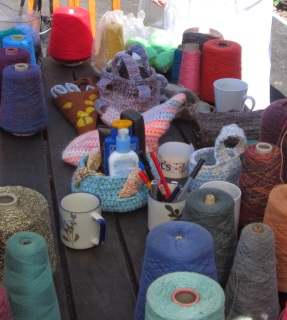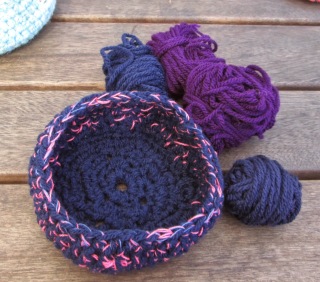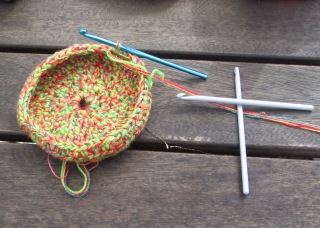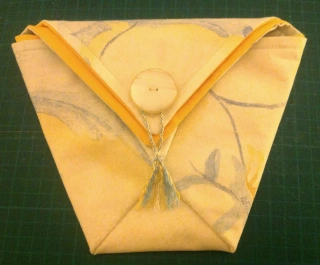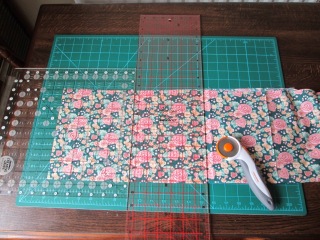 |
| My Sewing Project Folder |
 |
| The front of the sewing project folder |
This is the tutorial for the sewing project folder that I showed in my last blog post – here. Sorry for the mixture of imperial and metric measurements, for some reason I kept chopping and changing whilst I was making it!
These instructions are for a project folder which includes:
A needle case
Scissor keep
Tape measure grip
Pin cushion
Pocket for sewing wax
Pocket for tailor’s chalk
Full height project pocket
Sewing Project Folder Tutorial
 |
| Inside, showing the detachable pincushion |
 |
Inside the back cover of the
project folder |
Materials
½ yard of outer fabric [I used Poppies from Hillary’s Blinds)
½ yard of lining fabric [I used a canvas fabric from my stash]
½ yard of Light Synthetic Interlining
Felt in complementary colour measuring at least 7” x 3”
1 x 3cm button
2 x 1cm buttons
2” x 1” strip of hook and loop tape
10mm wide elastic
½ yd x ½” strip of ribbon
1 long and 2 shorter hair ties
Matching thread
Contrasting tacking thread
1 x A4 ring binder
2 x A4 zip-top clear plastic wallets
Corrugated cardboard
Thin wadding or foam
Tools required
Cutting mat
Rotary cutter
Craft knife
24” x 6” ruler
Pointer and creaser
Sewing machine
Pins
Large and small scissors
Hand sewing kit
Instructions
Carefully remove the metal ring binder bracket from the folder using a knife, screw driver or similar implement. Don’t worry if there are small holes in the folder as these will be hidden by the cover and interlining.
 |
| Measure and cut the outer fabric |
Using the rotary cutter and cutting mat, cut the outer fabric to fit your folder plus a ½” seam allowance on all sides. My fabric measured about 34” x 15” which included enough for the inside flap.
 |
| Lining fabric is measured and cut to size |
Cut the lining fabric and two pieces of interlining to the same size.
Cut one of each of the following pieces from the outer fabric and one each from the lining fabric:
Wax pocket 3¾” x 3½”
Tailor’s chalk pocket 4¼” x 3”
Pincushion 5½” diameter
Scissor keep Draw around your scissors making the shape shown in the picture
 |
Outer and lining fabrics cut to size
for pockets |
Using the craft knife, cut two circles of cardboard 4” diameter.
Using large scissors cut two circles from the thin wadding [or foam] 4” diameter.
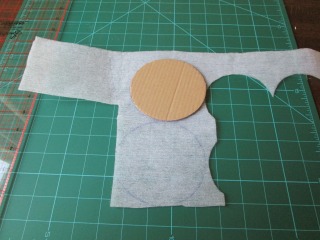 |
| Mark and cut the thin wadding |
Using either the rotary cutter and mat or the large scissors, cut a piece of felt measuring 7” x 3”
Pincushion:
 |
| Attach the loop tape with zigzag stitch |
Taking the piece of hook and loop tape, machine stitch the soft looped part to the centre of the right-side of the circle of lining fabric. Use a zigzag stitch and make sure the tape is firmly secured.
 |
Running stitch to gather edged of
pincushion |
Sew a running stitch around the lining fabric circle about ¼” in from the edge.
Place one circle of thin wadding [or foam] in the centre of the circle, on the wrong side, and put one cardboard circle on top. Pull the running stitch to tightly gather the fabric around the wadding and cardboard. Secure with stitching.
Repeats these steps for the circle made from the outer fabric.
 |
Stitch front and back of pincushion
together |
Place the two circles together with the rough edges facing and firmly stitch them together using a slip stitch.
 |
| The completed detachable pincushion |
Scissor keep:
 |
Fabrics being stitched right sides together
for scissor keep |
Place the outer and lining fabric shapes right sides together.
Machine stitch down one side, across the bottom and up the second side using a ¼” seam allowance and leaving the top edge open.
 |
The scissor keep has been turned right
sides out |
Using the pointer/creaser, turn the scissor keep so that the right side is out and press to neaten edges.
 |
| Stitching top edge together |
Fold in the top edges, pin together and neatly stitch ¼” in from the top edge.
Pockets for wax and tailor’s chalk:
Follow steps shown for the scissor keep for each pocket.
 |
Position the pockets and features on
lining |
Lay the lining fabric on your working surface, right side up and decide where you wish to place your pockets and other pieces, bearing in mind that there will be a large flap on the inside back of the folder. Pin each piece in place and stitch by machine or by hand, to secure. Fold the strip of felt in half and sew along the inside of the fold to secure it to the cover.
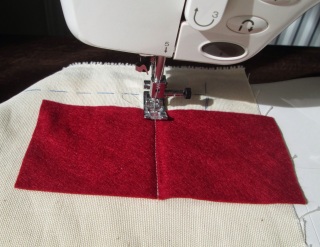 |
Stitch inside the fold to attach the
needle case |
Measure and cut two lengths of elastic, each to be stitched into a loop. Attach both loops to the cover to hold your tape measure.
 |
Elastic loops for tape measure to be
attached |
Add other pockets and loops as required.
Inserting the plastic wallets
Open the A4 folder and place it on your working surface with the inside facing uppermost.
Place the lining fabric on top of the folder, with the right side up and with the stitching line for the seam allowance for the left side exactly in line with the left hand edge of the folder.
Using the contrasting tacking thread, mark the entire edge of the folder on the lining fabric by tacking along the edge.
 |
The blue lines of tacking can be seen
in this picture |
Where the front of the folder meets the spine, mark on the lining fabric by tacking along the entire length of the fold. If you are using a plastic folder you will need just one row of tacking. If you are using a cardboard folder you will need to mark both sides of the ridge that forms on that fold. DO NOT tack along the fold on the other side of the spine.
The spine of my folder measured 1 3/8” [3.5cm] and the following measurements are based on that size, going from the farthest right hand tacking line and pinning each fold to secure. See picture for more explanation.
Measure 3/8” from the left down the entire length of that line. Make a valley fold in the fabric.
Measure 5/8” to the right and make a mountain fold
Measure 5/8” to the right and make a valley fold – this is Groove A.
Measure 5/8” to the right and make a mountain fold
Measure 5/8” to the right and make a valley fold
Measure 1 1/8” to the right and make a valley fold
Measure 5/8” to the right and make a mountain fold
Measure 5/8” to the right and make a valley fold – this is Groove B.
Measure 5/8” to the right and make a mountain fold
Measure 5/8” to the right and make a valley fold
Take one of the zip-top wallets and place it along Groove A. Pin it in place.
Using the sewing machine, stitch the wallet securely into the groove using a wide zigzag stitch. I did two rows of zigzag using a different stitch length for each row.
Insert the second wallet into Groove B in the same way.
 |
The edges have been secured with zigzag stitching
and must now be trimmed |
Do a double row of zigzag stitch across the top and bottom to secure the edges of the wallets and prevent fraying. Neatly trim the fabric back to the stitching.
 |
| Sewing the hair tie for the scissor keep |
Stitch the long hair tie above the scissor keep so that it will lop around the button.
 |
| The button for the scissor keep |
Stitch the large button on the scissor keep and a small button on each of the wax and tailor’s chalk pockets.
 |
| A small button is stitched onto each pocket |
Stitch a short hair tie above each pocket that has a small button, to loop over those buttons.
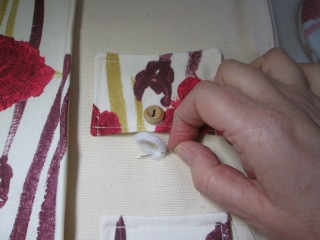 |
As I was sewing this after the folder was made
it was easier to turn the folder around! |
Lay the lining fabric on the working surface with the wrong side uppermost. Place the interlining on top and pin in place [with the pin on the right side of the lining] folding the seam allowance of the lining over the edges of the interlining. Repeat for the outer fabric.
 |
| Outer fabric and interlining pinned together |
Place the outer fabric on the working surface with the interlining uppermost. Place the outside of the A4 folder on the left hand side of the interlining leaving the seam allowance showing around the top, left and bottom edges.
 |
Outer fabric and lining fabric pinned
together |
Place the lining fabric on the inside of the folder, with the interlining face down. Align it with the outer fabric and pin in place around the top, left and bottom edges.
 |
| Stitching outer and inner together |
Machine stitch along the three pinned edges, using a straight stitch and keeping the row of stitching as close to the edge of the folder as you can. [I removed the folder before stitching but it could be left in place. If you do remove the folder, you should now slide it into the cover.]
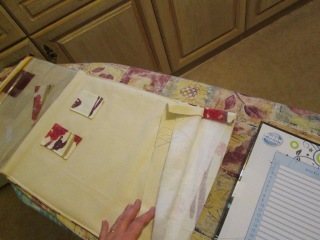 |
| Preparing to slide the folder into the cover |
Pin down the right hand edge then machine stitch in place, again keeping as close to the edge of the folder as possible.
 |
Stitching the right hand edge once the
folder is inside |
Fold in the seam allowances around the three loose edges of the flap and pin the outer and lining fabrics together.
Machine stitch around the three sides of the flap.
Fold the flap inside the back cover and stitch along the top and bottom to secure it. [I hand-stitched these because of the thickness of the fabric.]
 |
| Hand stitching the flap into position |
Cut the length of ribbon in half and attach one piece halfway down the open long edge on the front of the folder and the other opposite it on the back cover.
 |
| Stitching the ribbon tie into position |
Your sewing project folder is now complete.
 |
Sewing project folder, tailormade to your
own requirements
|





















































































































